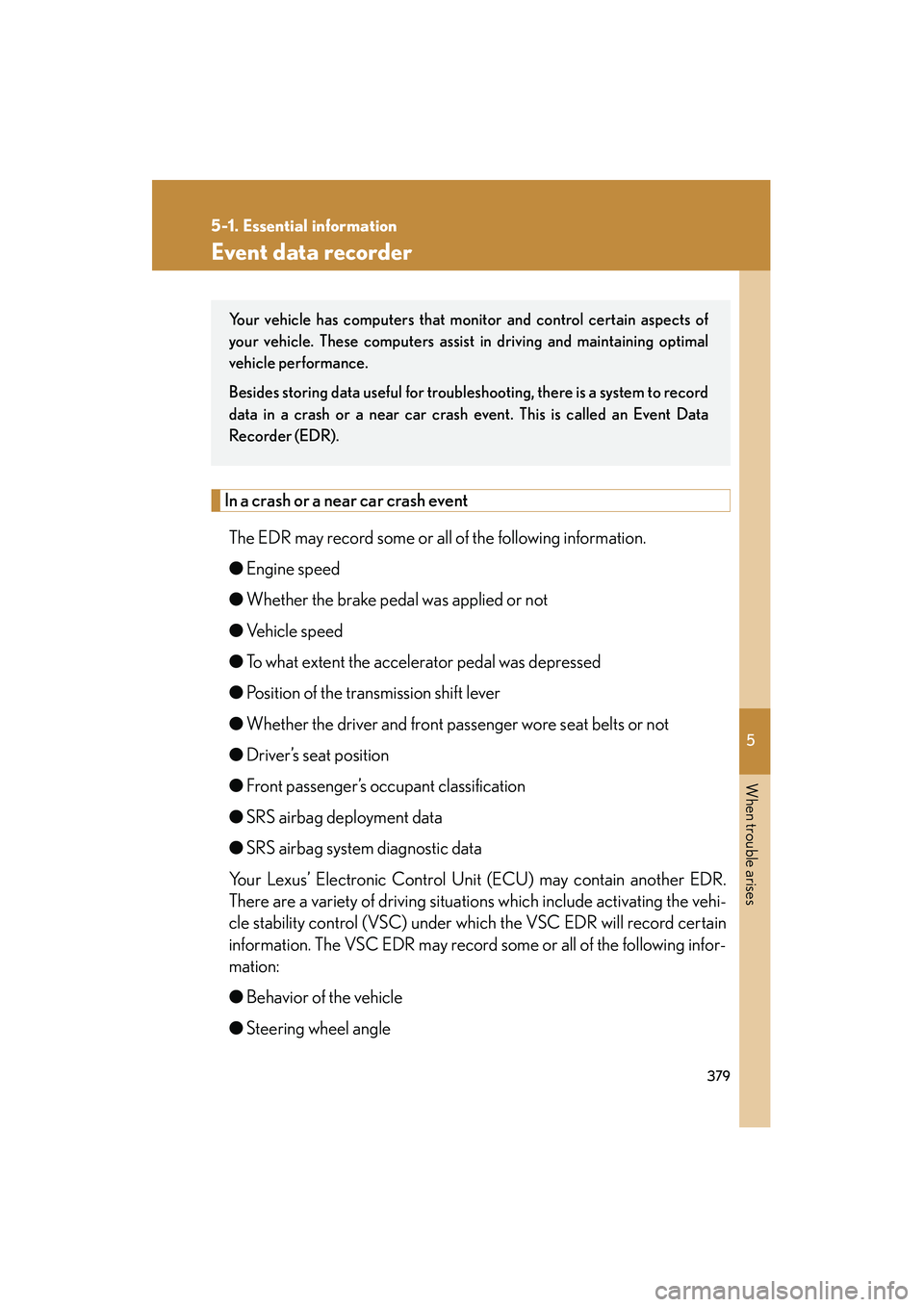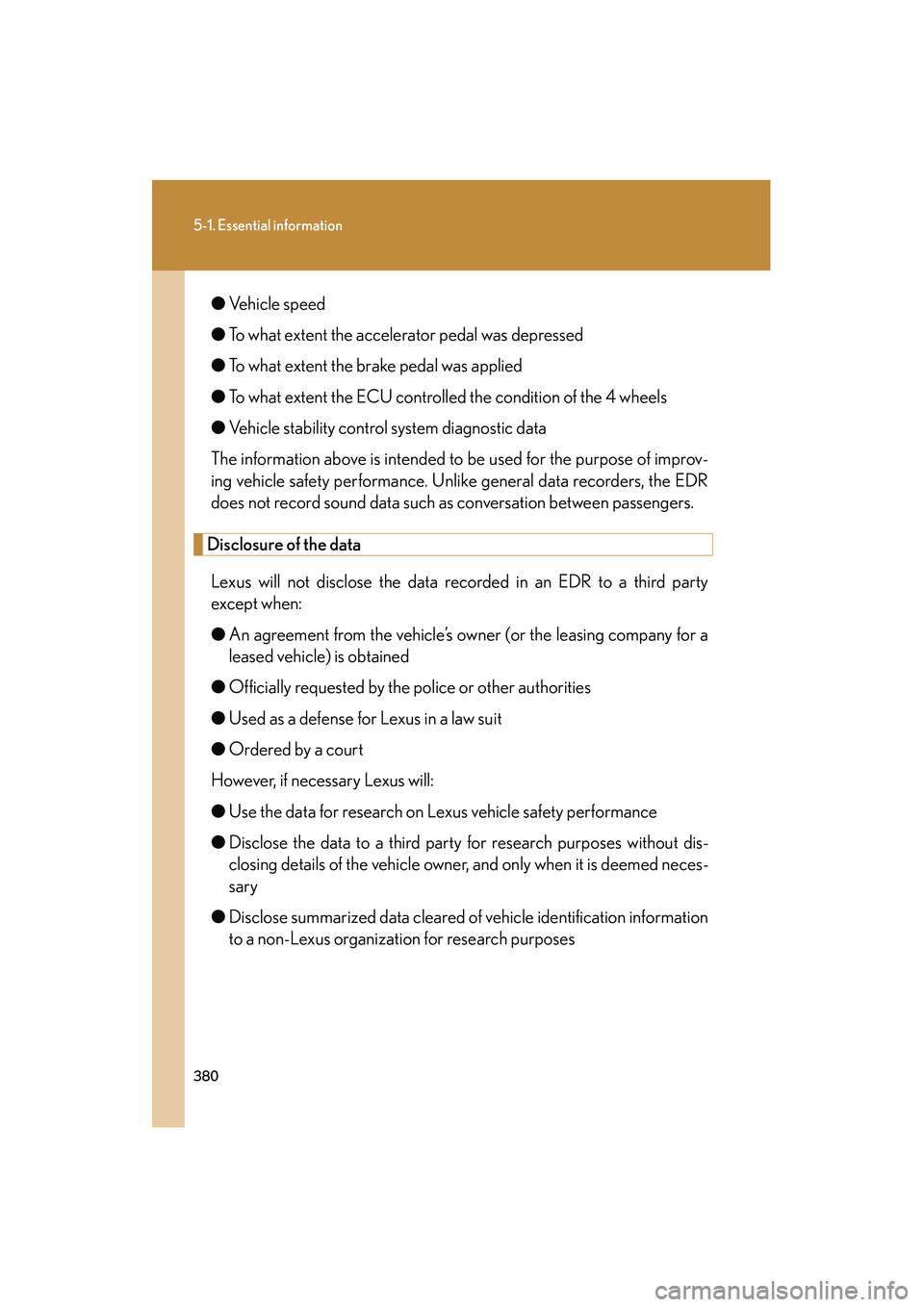Page 373 of 458

372
5-1. Essential information
If your vehicle needs to be towed
Before towingThe following may indicate a problem with your transmission. Contact
your Lexus dealer before towing.
● The engine is running, but the vehicle will not move.
● The vehicle makes an abnormal sound.
Emergency towing
If a tow truck is not available, in an emergency your vehicle may be tem-
porarily towed using a cable or chain secured to the emergency towing
eyelet. This should only attempted on hard, surfaced roads for short dis-
tances at low speeds.
A driver must be in the vehicle to steer and operate the brakes. The vehi-
cle’s wheels, drive train, axles, steer ing and brakes must be in good condi-
tion.
If towing is necessary, we recommend having your vehicle towed by your
Lexus dealer or a commercial towing se rvice, using a lift-type truck or a flat
bed truck.
Use a safety chain system for all towing, and abide by all state/provincial
and local laws.
The wheels and axle on the ground must be in good condition.
If they are damaged, use a towing dolly or flat bed truck.
Page 380 of 458

5
When trouble arises
379
5-1. Essential information
Event data recorder
In a crash or a near car crash eventThe EDR may record some or all of the following information.
● Engine speed
● Whether the brake pedal was applied or not
● Ve h i c l e s p e e d
● To what extent the accelerator pedal was depressed
● Position of the transmission shift lever
● Whether the driver and front passenger wore seat belts or not
● Driver’s seat position
● Front passenger’s occupant classification
● SRS airbag deployment data
● SRS airbag system diagnostic data
Your Lexus’ Electronic Control Unit (ECU) may contain another EDR.
There are a variety of driving situations which include activating the vehi-
cle stability control (VSC) under which the VSC EDR will record certain
information. The VSC EDR may record some or all of the following infor-
mation:
● Behavior of the vehicle
● Steering wheel angle
Your vehicle has computers that monitor and control certain aspects of
your vehicle. These computers assist in driving and maintaining optimal
vehicle performance.
Besides storing data useful for troubleshooting, there is a system to record
data in a crash or a near car crash event. This is called an Event Data
Recorder (EDR).
Page 381 of 458

380
5-1. Essential information
●Ve h i c l e s p e e d
● To what extent the accelerator pedal was depressed
● To what extent the brake pedal was applied
● To what extent the ECU controlled the condition of the 4 wheels
● Vehicle stability control system diagnostic data
The information above is intended to be used for the purpose of improv-
ing vehicle safety performance. Unlike general data recorders, the EDR
does not record sound data such as conversation between passengers.
Disclosure of the data
Lexus will not disclose the data recorded in an EDR to a third party
except when:
● An agreement from the vehicle’s owner (or the leasing company for a
leased vehicle) is obtained
● Officially requested by the police or other authorities
● Used as a defense for Lexus in a law suit
● Ordered by a court
However, if necessary Lexus will:
● Use the data for research on Lexus vehicle safety performance
● Disclose the data to a third party for research purposes without dis-
closing details of the vehicle owner, and only when it is deemed neces-
sary
● Disclose summarized data cleared of vehicle identification information
to a non-Lexus organization for research purposes
Page 387 of 458

386
5-2. Steps to take in an emergency
■If the malfunction indicator lamp comes on while driving
First check the following:
●Is your vehicle low on gas?
If it is, refuel the vehicle immediately.
●Is the fuel tank cap loose?
If it is, tighten it securely.
The light will go off after taking several driving trips.
If the light does not go off even after several trips, contact your Lexus dealer as soon
as possible.
■Front passenger detection sensor and passenger seat belt reminder
●If luggage is placed on the front passenger seat, the front passenger detection
sensor may cause the warning light to flash, even if a passenger is not sitting in
the seat.
●If a cushion is placed on the seat, the sensor may not detect a passenger, and the
warning light may not operate properly.
■SRS warning light
This warning light system monitors the following:
●The airbag sensor assembly
●Front airbag sensors
●The curtain shield airbag sensors
●The side and curtain shield airbag sensors
●The occupant detection system (ECU and sensors)
●“AIR BAG ON” and “AIR BAG OFF” indicator lights
●The driver’s seat position sensor
●The driver’s seat belt buckle switch
●Front passenger’s seat belt buckle switch
●The inflators
●The warning light
●The interconnecting wiring and power sources
Page 393 of 458
392
5-2. Steps to take in an emergency
Taking out the jack and toolsJack Remove the jack compartment
cover and take out the jack.
Tools Remove the tool tray compart-
ment cover and take out the tool
tray.
Jack handle Assemble the jack handle exten-
sion as shown. Be sure to tighten
each bolt securely.
Page 399 of 458
398
5-2. Steps to take in an emergency
Firmly tighten each nut two or
three times in the order shown in
the illustration.
Tightening torque:
83 ft•lbf (112 N•m, 11.5 kgf•m)
Reinstall the wheel ornament.
Stowing the flat/spare tire, jack and toolsLay down the tire with the outer
side facing up, and install the hold-
ing bracket.
Raise the tire.
Vehicles with kinetic dynamic suspension: Pull the tire towards
the rear of the vehicle when raising. After raising, visually check
that the tire is not interfering with suspension components.
Stow the tools and jack securely, and replace all covers.
STEP4
STEP5
STEP1
STEP5STEP2
STEP5STEP3
Page 400 of 458

5
When trouble arises
399
5-2. Steps to take in an emergency
CAUTION
■Using the tire jack
Improper use of the tire jack may lead to death or injuries due to the vehicle sud-
denly falling off the jack.
●Do not use the tire jack for any purpose other than replacing tires or installing and
removing tire chains.
●Only use the tire jack that comes with this vehicle for replacing a flat tire.
Do not use it on other vehicles, and do not use other tire jacks for replacing tires
on this vehicle.
●Always check that the tire jack is securely set to the jack point.
●Be sure to turn off the rear height control air suspension and stop the engine.
●Do not raise the vehicle while someone is in it.
●When raising the vehicle, do not put an object on or under the jack.
●Do not raise the vehicle to a height greater than that required to replace the tire.
●Use a jack stand if it is necessary to get under the vehicle.
●Do not put any part of your body under the vehicle supported by a jack.
●Do not start or run the engine while your vehicle is supported by the jack.
Take particular care when lowering the vehicle to ensure that no one working on or
near the vehicle may be injured.
■Using the jack handle
Tighten all the jack handle bolts securely using a Phillips-head screwdriver, to pre-
vent the extension parts from coming apart unexpectedly.
Page 435 of 458

434
6-1. Specifications
Tire related termMeaning
SidewallThat portion of a tire between the tread and bead
Sidewall separationThe parting of the rubber compound from the cord
material in the sidewall
Snow tire
A tire that attains a traction index equal to or greater
than 110, compared to the ASTM E-1136 Standard
Reference Test Tire, when using the snow traction
test as described in ASTM F-1805-00, Standard
Test Method for Single Wheel Driving Traction in a
Straight Line on Snow-and Ice-Covered Surfaces,
and which is marked with an Alpine Symbol ( )
on at least one sidewall
Te s t r i mThe rim on which a tire is fitted for testing, and may
be any rim listed as appropriate for use with that tire
Tr e a dThat portion of a tire that comes into contact with the
road
Tr e a d r i bA tread section running circumferentially around a
tire
Tread separationPulling away of the tread from the tire carcass
Treadwear indicators
(TWI)The projections within the principal grooves
designed to give a visual indication of the degrees of
wear of the tread
Wheel-holding fixtureThe fixture used to hold the wheel and tire assembly
securely during testing